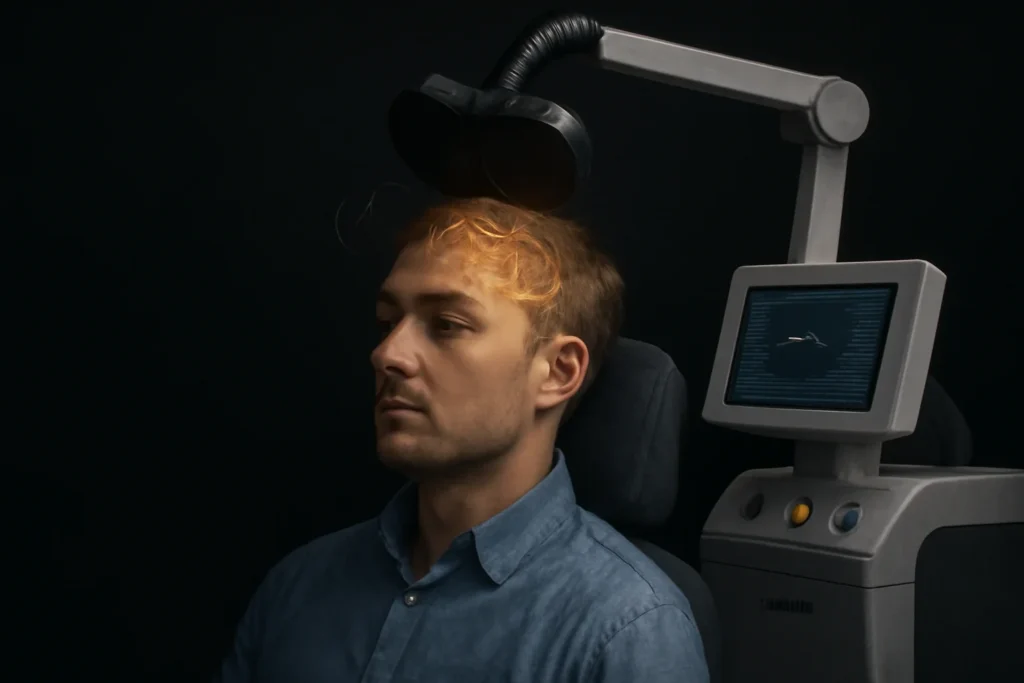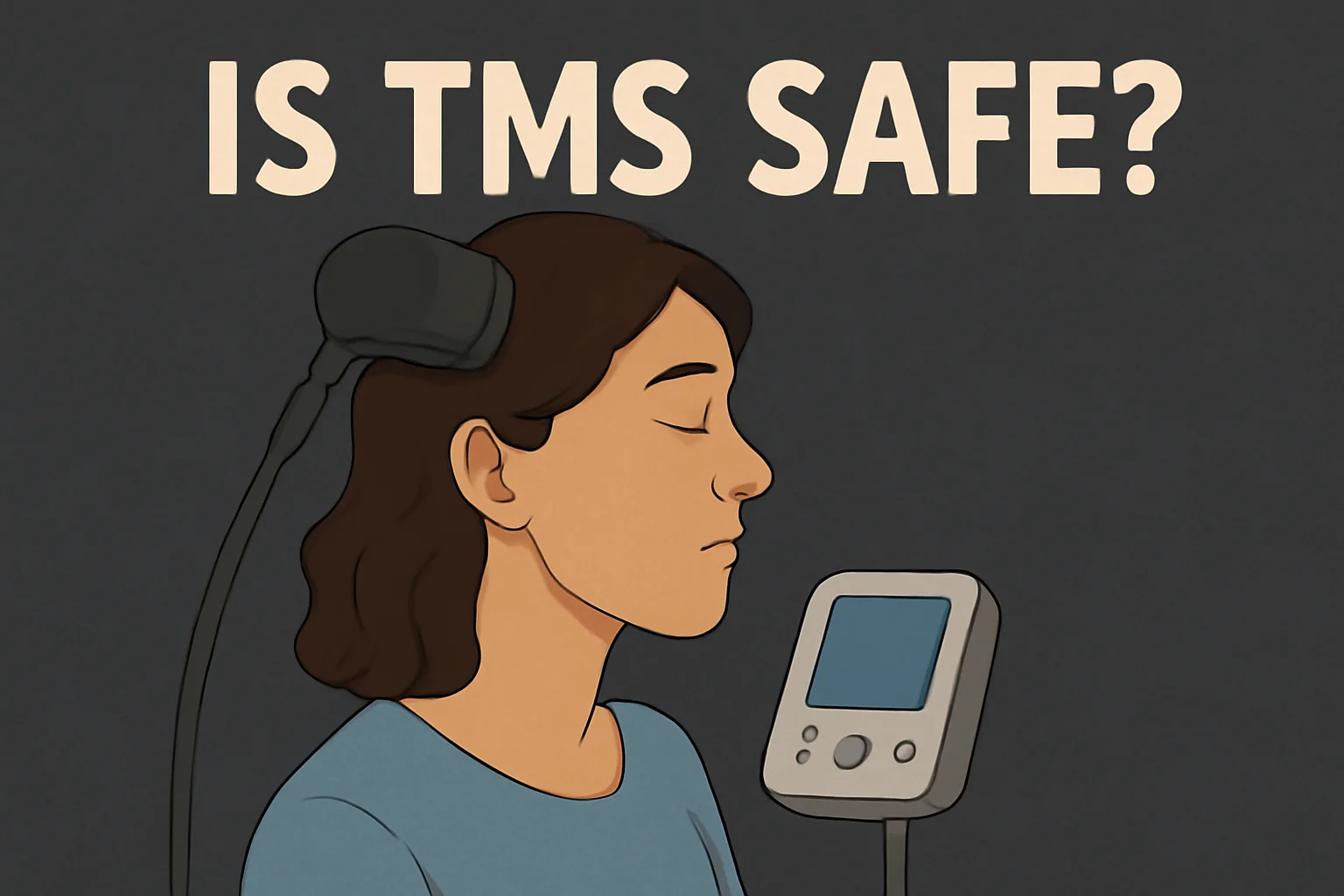Many patients considering TMS therapy have legitimate questions about its safety profile and effectiveness. This comprehensive guide addresses whether TMS therapy is safe by examining clinical evidence, debunking common myths, and highlighting the benefits of this FDA-approved, non-invasive treatment for individuals seeking alternatives to traditional mental health interventions.
The growing popularity of Transcranial Magnetic Stimulation reflects the increasing need for effective treatment options for patients who have not found success with conventional approaches. As traditional treatments like medications and psychotherapy prove inadequate for some individuals, TMS therapy has emerged as a promising alternative that offers hope without many of the limitations associated with other interventions.
What is TMS Therapy and How Does it Work?
TMS therapy uses targeted magnetic pulses to stimulate specific areas of the brain involved in mood regulation. The treatment works by delivering magnetic fields through a coil placed against the patient’s scalp, creating small electrical currents in the underlying brain tissue.
The magnetic stimulation targets the prefrontal cortex, an area of the brain that shows reduced activity in individuals with depression. By increasing neural activity in this region, TMS therapy helps restore more balanced brain function and can significantly improve mood symptoms.
Is TMS Safe? Addressing Common Concerns
How Safe is TMS?
Clinical research demonstrates that it is safe for the vast majority of patients who receive this treatment. The FDA approved TMS therapy in 2008 after extensive clinical trials showed both its effectiveness and safety for treating major depressive disorder.
Thousands of patients have received TMS therapy since its approval, with clinical data supporting its safety profile across diverse patient populations. Serious adverse events are extremely rare, occurring in less than 0.1% of treated patients according to large-scale studies.
The magnetic fields used in TMS therapy are similar in strength to those used in MRI scans, a medical procedure that has been safely performed millions of times worldwide. This comparison helps contextualize the safety of magnetic field exposure during TMS treatment.
Common Side Effects of TMS Therapy
While TMS therapy is safe for most patients, some individuals experience mild side effects that are typically temporary and well-tolerated. The most common side effects include:
- Scalp discomfort or pain at the treatment site during sessions
- Mild headaches that usually resolve within hours of treatment
- Facial muscle twitching during magnetic pulse delivery
- Lightheadedness or dizziness immediately after sessions
- Temporary hearing changes due to the clicking sound of the device
These side effects are generally mild and tend to decrease as patients become accustomed to the treatment. Most individuals find that any initial discomfort significantly improves after the first few sessions.
Potential Risks and How They’re Managed
The most serious potential risk associated with TMS therapy is seizure, though this occurs in less than 0.1% of patients. Healthcare providers carefully screen patients to identify those who might be at higher risk for seizures and take appropriate precautions.
Risk management protocols include thorough medical history reviews, medication assessments, and ongoing monitoring during treatment sessions. Trained technicians conduct all TMS sessions under physician supervision to ensure immediate response to any unexpected events.
Contraindications for TMS therapy include certain types of metal implants in the head or neck area, though many common dental work materials are considered safe. Healthcare providers conduct thorough evaluations to determine patient suitability before beginning treatment.

Is TMS Therapy Safe and Effective for Everyone?
Ideal Candidates for TMS Therapy
The question of whether TMS is safe and effective depends partly on patient selection and individual circumstances. Ideal candidates typically include adults with major depressive disorder who have not achieved satisfactory improvement with antidepressant medications.
Patients who cannot tolerate medication side effects often find TMS therapy particularly appealing due to its minimal systemic effects. The treatment works well for individuals seeking alternatives to increasing medication dosages or trying additional pharmaceutical interventions.
Age considerations generally favor adults, though research continues to explore TMS safety and effectiveness in adolescent populations under carefully controlled conditions.
TMS for Other Conditions Beyond Depression
Research continues to expand the applications of TMS therapy beyond depression treatment. Studies show promising results for conditions including anxiety disorders, obsessive-compulsive disorder, and certain pain conditions.
The safety profile of TMS remains favorable across these various applications, though treatment protocols may differ depending on the specific condition being addressed. Ongoing research continues to refine optimal treatment approaches for different patient populations.
TMS Therapy vs. Other Treatments: How Safe is TMS Compared to ECT and Medications?
TMS vs Electroconvulsive Therapy (ECT)
When comparing how safe TMS is to electroconvulsive therapy, TMS offers significant advantages in terms of side effects and treatment experience. Unlike ECT, TMS does not require general anesthesia, does not cause memory loss, and allows patients to maintain normal activities throughout treatment.
ECT involves intentionally inducing controlled seizures, while TMS uses targeted magnetic stimulation without affecting consciousness or causing seizures in properly screened patients. This fundamental difference explains why many patients and providers prefer TMS when both treatments are viable options.
The recovery time after TMS sessions is minimal compared to ECT, which requires significant recovery periods and can affect cognitive function for weeks or months after treatment.
TMS vs Medication
Comparing TMS safety to psychiatric medications reveals different risk profiles for each approach. While medications can cause systemic side effects, including weight gain, sexual dysfunction, and metabolic changes, TMS primarily causes localized, temporary effects.
Long-term medication use may require ongoing monitoring of liver function, cardiovascular health, and other organ systems. TMS therapy does not require such extensive medical monitoring beyond the treatment period itself.
However, the time commitment for TMS therapy is more intensive initially, requiring daily sessions for several weeks, compared to taking daily medication at home.
What to Expect During and After TMS Therapy: A Safe and Effective Process
What Happens During a TMS Session?
Understanding what occurs during TMS sessions helps address concerns about whether TMS is safe and comfortable for patients. Sessions take place in clinical settings with trained professionals who monitor patients throughout treatment.
Patients sit in comfortable chairs while technicians position the magnetic coil precisely against their scalp. The treatment device delivers magnetic pulses in specific patterns designed to optimize therapeutic benefits while maintaining safety.
Most patients describe the sensation as rhythmic tapping on the scalp accompanied by clicking sounds from the magnetic coil activation. Ear protection is provided to prevent hearing discomfort from the device noise.
Post-Treatment Care and Monitoring
The safety profile of TMS includes minimal post-treatment requirements compared to other brain stimulation therapies. Patients can drive themselves to and from appointments and immediately return to work or other activities.
Healthcare providers schedule regular check-ins to monitor treatment progress and address any concerns that arise during the treatment course. This ongoing monitoring ensures both safety and treatment optimization.
Long-Term Results and Safety
Long-term follow-up studies demonstrate that TMS therapy maintains its favorable safety profile over extended periods. Patients who respond well to initial treatment often experience sustained benefits without ongoing safety concerns.
The absence of long-term systemic effects makes TMS particularly appealing for patients concerned about the cumulative health impacts of chronic medication use.

Debunking Common Myths About TMS Therapy
Myth 1: TMS Is the Same as Electroconvulsive Therapy (ECT)
One persistent misconception confuses TMS with ECT, leading to unnecessary fears about treatment safety and experience. These treatments differ fundamentally in their mechanisms, side effects, and patient experience.
TMS uses magnetic fields to stimulate brain tissue without affecting consciousness, while ECT uses electrical current to induce controlled seizures under general anesthesia. The safety profiles and treatment experiences are completely different.
Myth 2: TMS Is Dangerous or Unproven
Some individuals worry that TMS is experimental or dangerous, despite extensive research supporting its safety and effectiveness. FDA approval required rigorous clinical trials demonstrating both safety and efficacy for treating depression.
Ongoing research continues to refine TMS protocols and expand its applications, but this represents advancement rather than uncertainty about basic safety and effectiveness.
Myth 3: TMS Causes Brain Damage
Concerns about brain damage reflect misunderstandings about how magnetic stimulation affects neural tissue. TMS enhances natural neural activity rather than causing tissue damage, and research shows no evidence of harmful structural brain changes.
The magnetic fields used in TMS are within safe ranges established through decades of research on magnetic field exposure in medical settings.
Making Informed Decisions About TMS Therapy
The evidence clearly demonstrates that it is safe for appropriately selected patients when administered by qualified healthcare professionals. The treatment offers a non-invasive alternative for individuals who have not found success with traditional approaches or who cannot tolerate medication side effects.
Patients considering TMS therapy should consult with experienced mental health providers who can assess their individual circumstances and treatment history. These consultations help determine whether TMS represents an appropriate next step in their mental health treatment plan.
